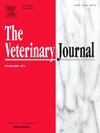Placebo is non-inferior to postoperative antimicrobial treatment in uncomplicated canine pyometra – A double-blinded randomized controlled trial
IF 3.1
2区 农林科学
Q1 VETERINARY SCIENCES
引用次数: 0
Abstract
Postoperative antimicrobial therapy is frequently administered after surgical treatment for pyometra in dogs, despite limited evidence supporting its necessity in uncomplicated cases. Antimicrobial resistance concerns call for re-evaluation of such practices. This randomized, double-blinded, placebo-controlled, non-inferiority clinical trial was conducted on client-owned dogs at the Veterinary Teaching Hospital of the University of Helsinki. All dogs received perioperative sulfadoxine-trimethoprim prophylaxis and were then randomized to receive either placebo or a five-day course of oral sulfadiazine-trimethoprim as active control. The primary outcome was the incidence of surgical site infections (SSI) within 30 days; the secondary outcome was the incidence of clinical urinary tract infections (UTI) within 12 days. The non-inferiority margins were set at 7 % (SSI) and 15 % (UTI). Infection outcomes were assessed in both the intention-to-treat (ITT) and per-protocol populations (PP). A total of 152 dogs were included. In the ITT population, SSI incidence was 2.7 % in the placebo group and 7.8 % in the sulfadiazine-trimethoprim group, with an absolute difference of –5.1 % (CI95 %: –13.6–2.8 %). UTI incidence was 0 % in the placebo group and 3.9 % in the sulfadiazine-trimethoprim group (difference −7.7 %, CI95 %: –24.1–8.2 %). Results in the PP were similar. All findings supported the non-inferiority of placebo. A single perioperative dose of sulfadoxine-trimethoprim appears sufficient for preventing postoperative infections in this low-risk surgical population.
一项双盲随机对照试验表明,在无并发症的犬脓脓症中,安慰剂不逊于术后抗菌药物治疗。
术后抗微生物治疗经常在手术治疗犬脓脓后进行,尽管有限的证据支持其在无并发症病例中的必要性。抗菌素耐药性问题要求对这些做法进行重新评估。这项随机、双盲、安慰剂对照、非劣效性的临床试验是在赫尔辛基大学兽医教学医院对客户拥有的狗进行的。所有狗都接受围手术期磺胺嘧啶-甲氧苄啶预防治疗,然后随机接受安慰剂或口服磺胺嘧啶-甲氧苄啶作为主动对照。主要观察指标为30天内手术部位感染(SSI)的发生率;次要观察指标为12天内临床尿路感染(UTI)的发生率。非劣效性裕度分别为7% (SSI)和15% (UTI)。在意向治疗人群(ITT)和按方案人群(PP)中评估感染结果。总共包括152只狗。在ITT人群中,安慰剂组SSI发生率为2.7%,磺胺嘧啶-甲氧苄氨嘧啶组为7.8%,绝对差异为-5.1% (CI95%: -13.6%至2.8%)。安慰剂组尿路感染发生率为0%,磺胺嘧啶-甲氧苄啶组为3.9%(差异为-7.7%,CI95%: -24.1%至8.2%)。PP的结果相似。所有研究结果均支持安慰剂的非劣效性。单次围手术期剂量磺胺多辛-甲氧苄啶似乎足以预防这类低风险手术人群的术后感染。
本文章由计算机程序翻译,如有差异,请以英文原文为准。
求助全文
约1分钟内获得全文
求助全文
来源期刊

Veterinary journal
农林科学-兽医学
CiteScore
4.10
自引率
4.50%
发文量
79
审稿时长
40 days
期刊介绍:
The Veterinary Journal (established 1875) publishes worldwide contributions on all aspects of veterinary science and its related subjects. It provides regular book reviews and a short communications section. The journal regularly commissions topical reviews and commentaries on features of major importance. Research areas include infectious diseases, applied biochemistry, parasitology, endocrinology, microbiology, immunology, pathology, pharmacology, physiology, molecular biology, immunogenetics, surgery, ophthalmology, dermatology and oncology.
 求助内容:
求助内容: 应助结果提醒方式:
应助结果提醒方式:


